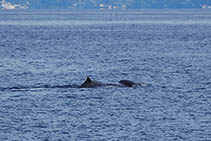| Family: |
Physeteridae (sperm whales) |
| Max. size: |
2400 cm TL (male/unsexed); 1200 cm TL (female); max.weight: 57,000 kg |
| Environment: |
pelagic; marine; depth range 0 - 3200 m, oceanodromous |
| Distribution: |
Circumglobal. |
| Diagnosis: |
|
| Biology: |
Largest sperm whale (Ref. 1394). Sperm whaling has a long history. The most intense periods were the Yankee whaling era of the 1800s and the factory ship whaling of the 20th century. Recent findings of studies on social behavior and breeding undermine assumptions in the models on which exploitation and management have long been based. Certain populations have been depleted, but the sperm whale remains the most abundant of all the great whales (Great whales generally include the sperm whale and all baleen whales, except the pygmy right whale) (Ref. 1394). Maximum size of female species based from Ref. 1394. Deep divers. Feeds on squids, octopuses (Ref. 1394), sharks, demersal rays, and bony fishes (Ref. 122680). Forms strong social bonds (Ref. 122680). |
| IUCN Red List Status: |
Vulnerable (VU); Date assessed: 30 June 2008 (A1d) Ref. 123251)
|
| Threat to humans: |
|
| Country info: |
|
Source and more info: www.sealifebase.org. For personal, classroom, and other internal use only. Not for publication.

